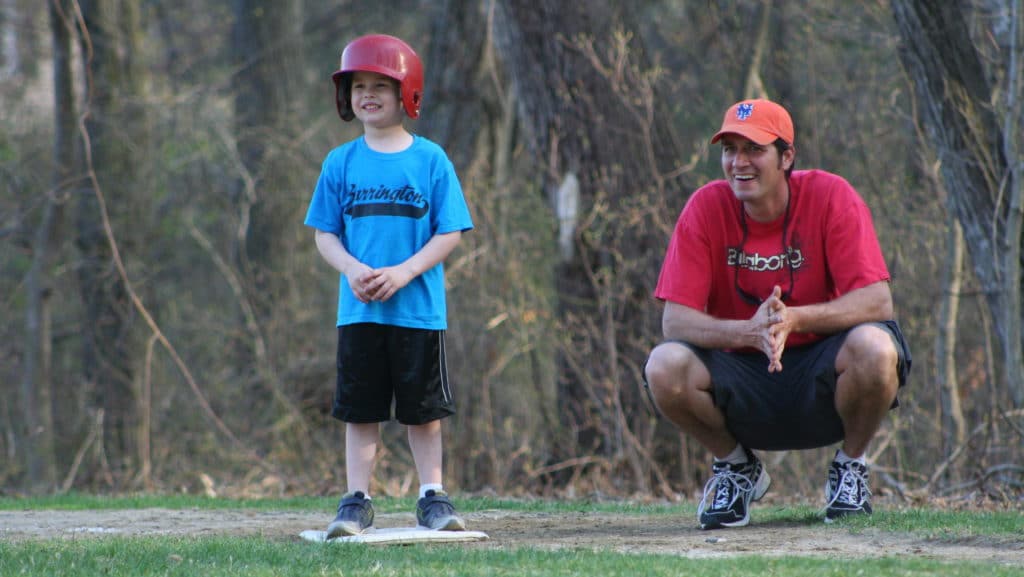Youth baseball and softball can be a safe-haven for kids dealing with turbulent lives outside the chalk lines. It can offer much-needed structure, foster friendships that extend beyond the ball fields, and promote the skills kids need to thrive.
Or it can become a storm of unnecessary stress, a breeding ground for burnout, and a toxic place that contributes to overuse injuries and exacerbates the challenges that kids face in their day-to-day lives.
The way coaches and parents approach youth sports can be detrimental to children, even when they have good intentions. Pushing kids to train more and play harder may seem harmless, but there comes a point when it goes beyond healthy and productive motivation.
The bottom line is that relentlessly pressuring kids can lead to burnout and can negatively impact the already fragile mental health of adolescence.
As a child, I didn’t play Wiffle ball or join the local t-ball team because I wanted to push my limits and prove that I was worthy of a scholarship. I played because I wanted to have fun, spend time with friends, and overcome the “bottom of the ninth, bases loaded, two outs” challenge.
At this point in my life, playing softball was my favorite thing in the world. That is, until it wasn’t. The sport that once offered a place to get a break from my own mind started to become a chore, a stressful rhythm of practice every day after school, then coming home to do homework, go to sleep, and repeat it all over again the next day.
“I don’t care if you have to stay up until 1 in the morning to finish your homework. Don’t miss practice,” our coach would say.
The message was clear: nothing else besides softball really mattered. Not the Sunday night dread about the five exhausting days ahead of me, or the panic attacks I started experiencing my freshman year, or the thoughts that got darker and darker as the years went on.
I was afraid to speak up — often about physical injuries — for fear of being berated in front of my teammates.
I quickly learned that to keep my head above water, doing what I loved had to take a back seat to proving myself, my abilities, and my worth to the coaches in front of me — and of course, to the potential ones at the next level.
I fought a newfound hatred for the sport I once loved, hoping the joy would eventually return. But it never did. So I quit, with nothing to show for my efforts besides one less healthy coping skill than when I began.
How to Prevent Burnout in Youth Sports
When this burnout collides with the social and emotional changes kids experience as they grow, it creates a perfect storm for mental health challenges.
Baseball and softball can provide so much more than the hope of a future scholarship or professional contract, but coaches and parents have to shift their thinking.
- Step back and look at the big picture. Losing a balance of teaching important skills and cultivating a fun environment is a recipe for burnout.
- Pushing kids into extra training and practice with no regard for rest and recovery is unsustainable, and sends a silent but undeniable message about priorities.
- Trust kids when they say they need a break. Warning signs are often present but go unnoticed or ignored until the child is completely burnt out.
The purpose of youth sports has shifted away from developing healthy, well-rounded children in a fun environment towards exploiting the game via year-round specialization to propel kids to the next level.
But in prioritizing winning and individual results, coaches and parents lose sight of why kids play sports in the first place: because it’s fun. They enjoy the challenge of hitting the ball and getting to first base safely and spending time with their teammates.
Winning can be fun too, but the enjoyment comes from the experience, not just the result. Shifting our focus away from winning and results and towards encouraging effort and passion is a great place to start.
Related: Finding the right balance between enjoyment and development is one of our most important youth baseball coaching tips.
Prioritizing Effort and Passion
A fun, enjoyable, and productive experience needs a balance. When the focus is on winning at all costs, kids feel the pressure and may lose enthusiasm if they go through a slump.
When expectations are too high and the game isn’t fun, feeling burnt out is a natural reaction. If, however, the scale tips the other way and a lack of structure comes at the expense of fun, they may get bored and decide baseball isn’t for them.
The balance, then, incorporates teaching fundamental skills, practicing those skills, and fostering an environment where kids have fun and feel safe.
When lost in the frenzy of winning, the big picture is often blurred. We’re here to raise good kids, not just good athletes. Youth baseball and softball offers an opportunity to nurture all areas of child development. It’s a unique learning opportunity because kids are given a chance to learn and grow through play that happens outside of a classroom setting. The lessons learned on the diamond are ones that kids can apply to different areas of their lives.
Coaches have a duty to provide a safe, healthy learning environment and a responsibility to support the physical, intellectual, social, and emotional development of children in their care.
While training coaches in early childhood education may not be feasible from a time and resources standpoint, I believe regularly guiding and reminding coaches that youth baseball and softball can benefit more than just physical development is a place to start.
Youth Baseball and Softball Can Nurture All Areas of Development
- Physical: Participating in youth baseball and softball gets kids to exercise and live an active lifestyle. They can also practice and improve motor skills, coordination, and strength.
- Intellectual: Youth baseball and softball introduces new concepts and strengthens existing ones. Kids can listen to a coach’s instruction then try out a drill for themselves, work on problem-solving skills, and set and achieve goals. They can learn to be resilient by trying again in their second at-bat after striking out the first time.
- Social: Youth baseball and softball provides an opportunity to make friends, build positive relationships, and learn teamwork. As they cheer their teammates on and start to make friends, kids learn vital communication skills.
- Emotional: Kids learn very quickly that baseball and softball are a game of success and failure. These sports can help kids build self-confidence and learn how to cope with failure. They’ll also learn how to express themselves, relate to their peers, and give and receive encouragement.
These lessons occur naturally when kids are having fun, but burnout happens when they feel trapped by external pressure. What was once fun may now feel like a chore, leading to resentment and anger. The stress from being pushed too hard removes the joy kids felt when they first picked up a baseball. The less pressure we put on them, the more we rekindle that joy.
There’s so much more to the sport than what’s shown on the scoreboard.
The Argument Against Youth Sport Specialization
Nearly 15 million children played youth baseball in 2016. Although interest in youth baseball is on the rise recently, participation over the last few decades is waning as a greater emphasis is put on intense training for one sport year-round. Of the millions of children who played youth sports in 2016, an overwhelming 70% are likely to quit by the time they turn 13 years old.
Even though specializing early on may give kids a head start against multi-sport athletes, it doesn’t necessarily come without consequences or make them better prepared to play at the next level.
Different Sports Teach Different Skills
College and professional opportunities are thin, and it doesn’t matter how much of a head start a child gets if they stop playing because they’re burnt out. While the intentions may be good, relentlessly pushing kids into one sport deprives them of the chance to learn a variety of skills by playing other sports.
If they try basketball, football and soccer, and decide to stick with baseball down the line, the skills they learned from other sports will benefit them in a way that forced specialization never will. Kids should be encouraged to figure out what they love and let that motivate them.
Taking a Break is Necessary
“There is no offseason” is a common phrase when kids are funneled into one sport. This warped motivation strategy reminds me of something I heard a lot as a late teenager and now a young adult: If you do what you love, you’ll never work a day in your life.
There’s a line between healthy motivation and harmful pressure, and these ideas cross that line. Even if you enjoy doing something, forbidding yourself from stopping to catch your breath is a direct path to being burnt out.
It’s OK to acknowledge that the thing you love is also stressful. You’re allowed to rest and recover; your future self will thank you.
The same goes for youth athletes whose bodies and minds are still growing and changing. Pushing them to condition and practice without adequate rest and recovery time will lead to overuse injuries.
The Impact on Mental Health
Kids often vocalize that they’re tired or their arm hurts, but are often told “you’re fine, keep going.”
When adults ignore these concerns, kids begin to second guess the message their body sends to them. And while physical overuse injuries are usually visible, pushing kids sends an invisible message too. We may not want to think kids struggle with their mental health, but ignoring the fact that they do leads to long-lasting consequences.
- 16.5% of U.S. youth aged 6-17 experienced a mental health disorder in 2016. Only half received treatment.
- 50% of all lifetime mental illness begins by age 14.
When we think about the fact that while millions of kids love to play youth baseball and softball the majority drop out around 13 years old, it’s jarring to recognize that right around the same age is when half of all lifetime mental illnesses begin.
Kids play baseball because it’s fun. For many, it’s also a safe environment where they don’t have to think about the obstacles they’ll face at home or at school. When they get pushed too hard and feel trapped by stress, they start to burn out and the healthy and positive outlet they had is now gone.
If they say they need a break and get ignored, that will stick with them the next time they need to ask for help — whether it’s on the field or off. If they weren’t taken seriously when they said they needed a break, why would they think it would be any different when they bring up bigger stuff like “I’m struggling to cope” or “I’m feeling anxious and depressed?”
We have to start believing kids when they tell us, explicitly and implicitly, that they need a break. When they tell you verbally, give them your attention and trust what they’re saying. Some kids won’t vocalize that they’re struggling, but they need help too. Mental Health America and the National Athletic Trainers’ Association have resources to help educate coaches and parents about athlete burnout.
Signs and Symptoms of Youth Sports Burnout
- Leveling off or diminished performance or conditioning, including strength and stamina losses, chronic fatigue.
- Physiological signs such as having a higher resting heart rate and blood pressure.
- Cognitive issues such as difficulty in concentration or diminished work in school, forgetfulness.
- Illnesses as a result of suppressed immune system.
- Emotional issues such as disinterest, moodiness and irritability.
- Low self-esteem, increased anxiety and depression as a result of falling short of sport demands.
The best way to prevent and treat burnout is to allow time for rest and recovery. Pause your expectations, stop applying pressure and let them take a break. Encourage healthy coping skills, like vocalizing how they’re feeling, expressing themselves through art or music, and taking deep breaths.
We can’t completely avoid burnout, but we can take proactive steps to prevent it as best we can and cope with it in healthy ways.
Youth baseball and softball can be a positive way for kids to learn important skills while doing something they love. When they’re encouraged to do their best and have fun, they learn how to work together, be resilient and build confidence.
Allowing kids to try a variety of sports and activities gives them a chance to figure out who they are and what they enjoy doing. If they’re starting to feel burnt out, encourage them to take a break. Giving them enough time to rest and recover is a way to help them learn that their whole identity isn’t just being an athlete.
Support, encouragement, and love shouldn’t be tied to athletic performance and accomplishments. Because being an athlete is something we do, not who we are.







Jon Firmature
November 10, 2021 at 10:45 am
Thaks for the great oversight and perspective!
Nicole Cahill
November 10, 2021 at 4:04 pm
Thank you for reading, Jon!
Gina Cunicelli-Carlton
January 11, 2022 at 12:46 pm
Love the insight and data. I’m going to share with my students.
Nicole Cahill
January 25, 2022 at 12:26 pm
Just seeing this now, but thank you Gina!!